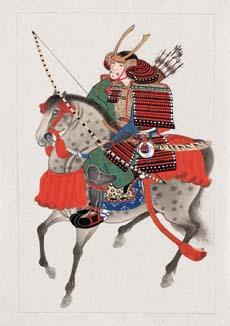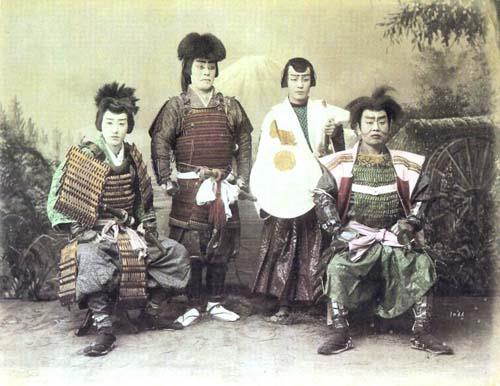Samurai
Posted by MRL on Dec 31st 2006
Code of Bushido
Little represents the idolized samurai and their code of bushido better than their sword, the katana. Although not the only weapon available to samurai, the sword is the only weapon that has remained constant to the samurai throughout time. The katana (long sword), the wakizashi (medium sword) and the tanto (short sword) haven't always been the primary weapon of choice for warfare, however. Yabusame, the art of horseback archery, has often seen its share of experience in combat. The Naginata, a pole weapon consisting of a shaft with a long curved blade mounted to the end, was another favorite to samurai on and off the battlefield.

Originally, battles including samurai were determined by hundreds or thousands of individual duels similar to archaic Greek warfare before the rise of the hoplite. As new weapons were introduced to the battlefield, the tactics of battles changed. Samurai using longbows, the yumi, could skirt the edge of battle picking off individual men or charge into the fight bearing a katana to cut a path of death on the field. Peasants using more rudimentary pole arms could negate the effects of horseback samurai and thus a counter tactic would have to be developed. In this way the tactics and weapons of samurai evolved in order to meet the requirements that different situations called for.
Despite the changing technology and tactics of warfare, or even during times of peace, the katana and its sister swords remained a constant for true samurai. The katana was the primary sword, used one handed or two handed in battle. The wakizashi was a secondary weapon always at a samurais side. Should the situation call for their katana to be removed, such as appearing in a nobles home, the wakizashi would remain in its place on the samurai. The tanto was used primarily to commit seppuku, or ritual suicide in the case of dishonor. Often given personal names, the swords became an extensive of the owner.
The samurai remained in a position of honor until industrialization rendered them obsolete. Masses of men using firearms and more modern battle tactics emerged to replace the samurai on the battlefield. As privilege after privilege was removed from them, the samurai slowly began to fade into legend. To this day, however, the sword of the samurai carries their legacy on.
by Alex Smith, MRL staff writer

Kabuki actors dressed like samurai, hand colored photograph c 1880

Originally, battles including samurai were determined by hundreds or thousands of individual duels similar to archaic Greek warfare before the rise of the hoplite. As new weapons were introduced to the battlefield, the tactics of battles changed. Samurai using longbows, the yumi, could skirt the edge of battle picking off individual men or charge into the fight bearing a katana to cut a path of death on the field. Peasants using more rudimentary pole arms could negate the effects of horseback samurai and thus a counter tactic would have to be developed. In this way the tactics and weapons of samurai evolved in order to meet the requirements that different situations called for.
Despite the changing technology and tactics of warfare, or even during times of peace, the katana and its sister swords remained a constant for true samurai. The katana was the primary sword, used one handed or two handed in battle. The wakizashi was a secondary weapon always at a samurais side. Should the situation call for their katana to be removed, such as appearing in a nobles home, the wakizashi would remain in its place on the samurai. The tanto was used primarily to commit seppuku, or ritual suicide in the case of dishonor. Often given personal names, the swords became an extensive of the owner.
The samurai remained in a position of honor until industrialization rendered them obsolete. Masses of men using firearms and more modern battle tactics emerged to replace the samurai on the battlefield. As privilege after privilege was removed from them, the samurai slowly began to fade into legend. To this day, however, the sword of the samurai carries their legacy on.
by Alex Smith, MRL staff writer

Kabuki actors dressed like samurai, hand colored photograph c 1880


